Abstract
Strains of Streptococcus pneumoniae resistant to penicillin have been reported from several countries around the world. Many South African isolates, in addition, exhibit resistance to tetracycline, chloramphenicol, erythromycin, clindamycin, and cotrimoxazole in varying patterns. A qualitative test of the ability of antibiotic-resistant pneumococci to inactivate penicillin, oxacillin, cephalothin, cefoxitin, chloramphenicol, tetracycline, minocycline, erythromycin, clindamycin, streptomycin, gentamicin, and cotrimoxazole revealed that only chloramphenicol was degraded. This finding was confirmed in a quantitative test in which the residual antimicrobial activity of broth containing chloramphenicol in subinhibitory concentrations was determined after incubation with antibiotic-resistant bacteria. Chloramphenicol resistance was shown to be associated with the production of inducible chloramphenicol acetyltransferase. No beta-lactamase activity was demonstrated. Plasmid deoxyribonucleic acid was not demonstrable in partially purified lysates of antibiotic-resistant strains of S. pneumoniae.
Full text
PDF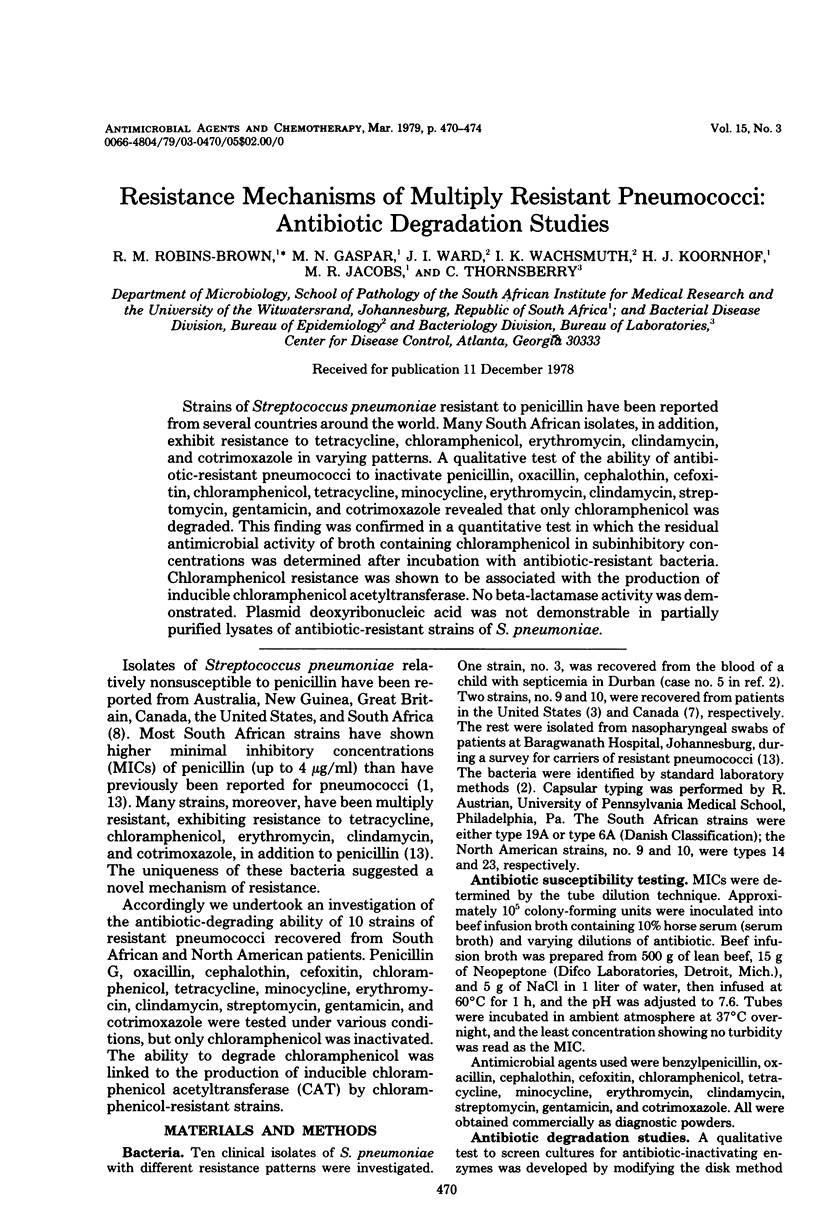
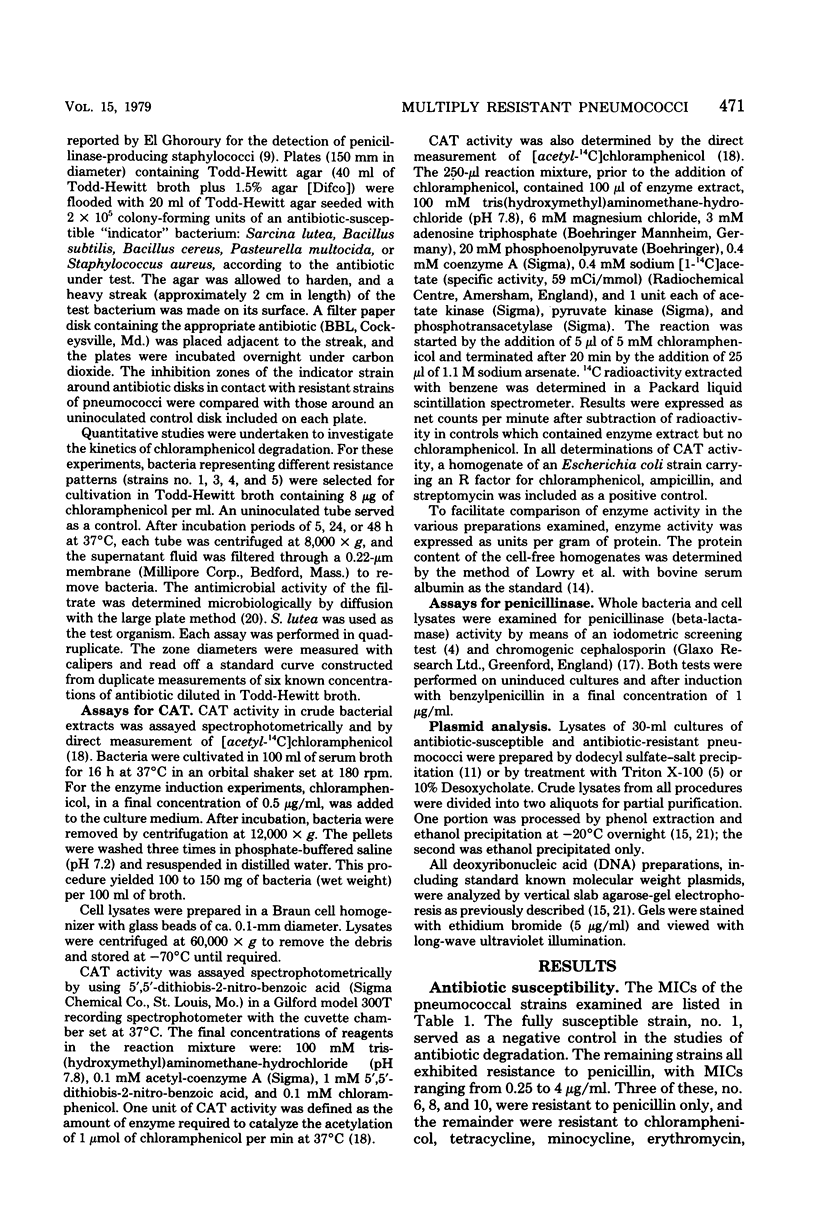
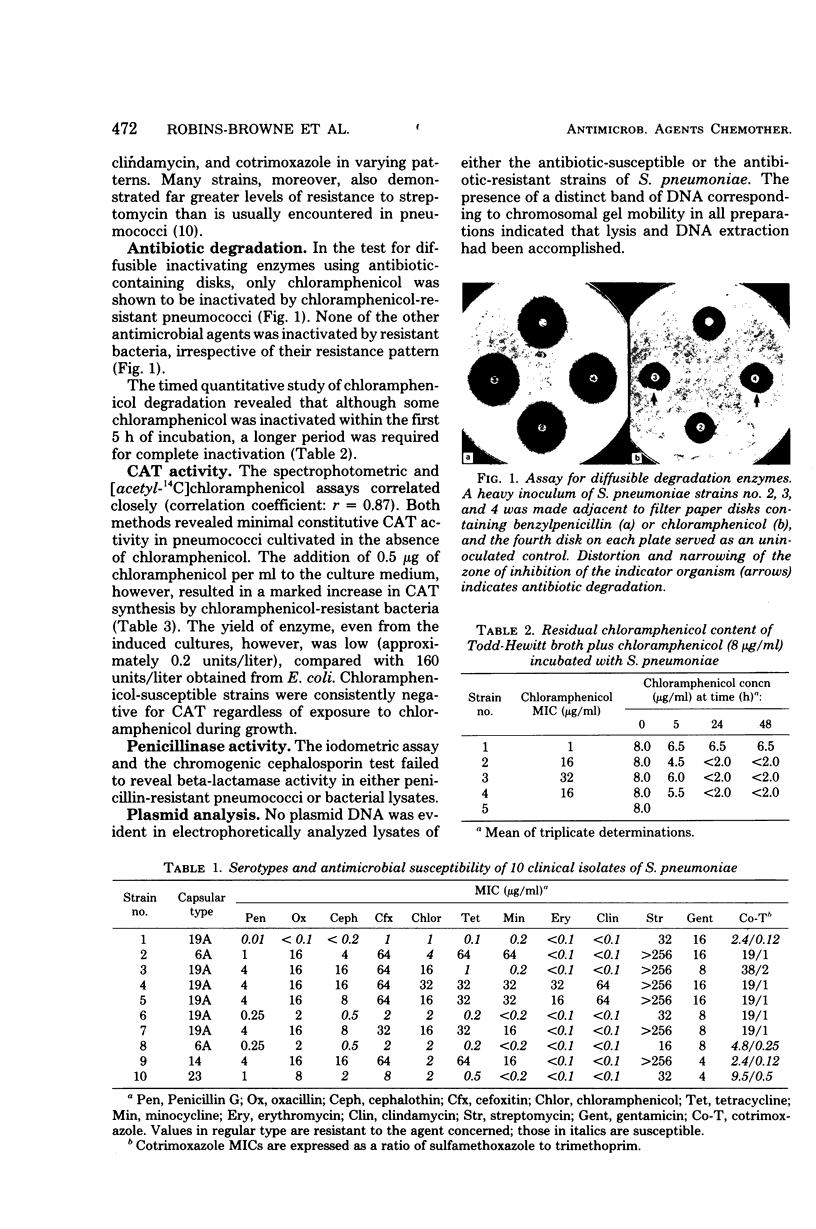
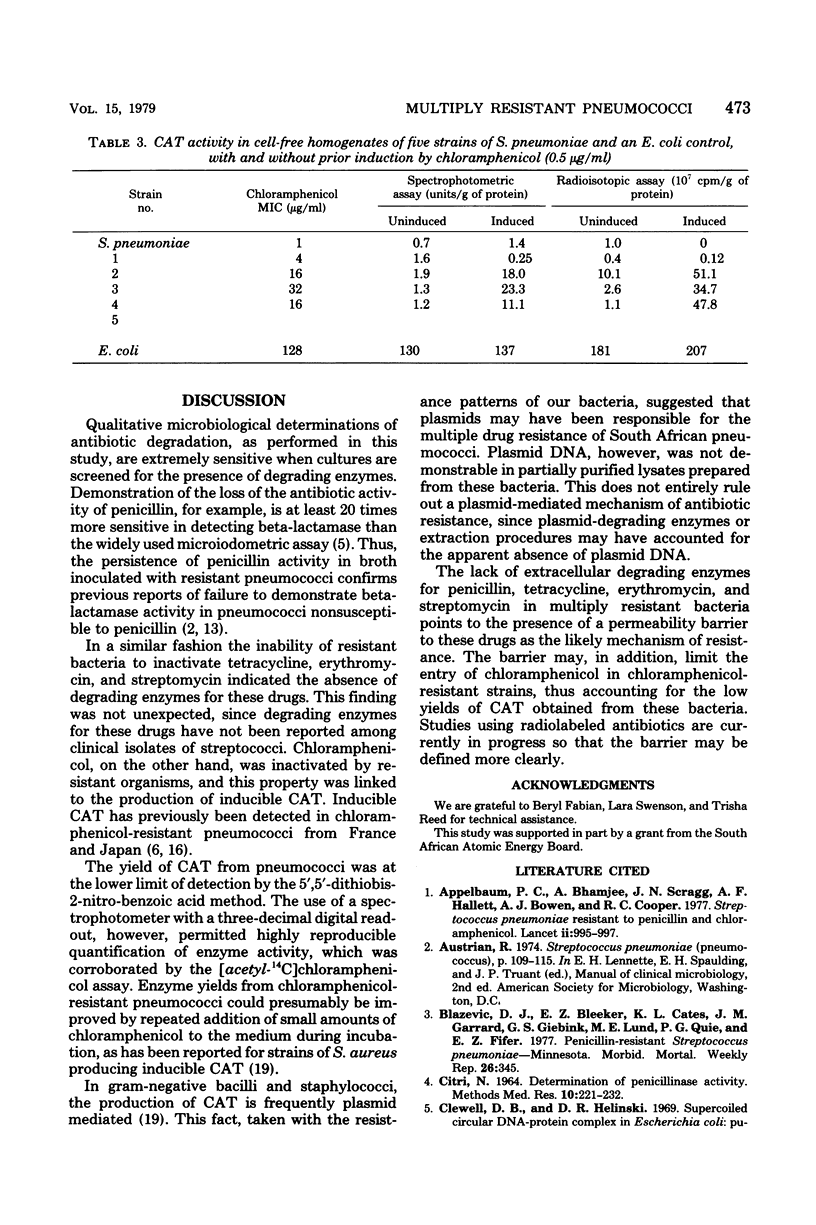
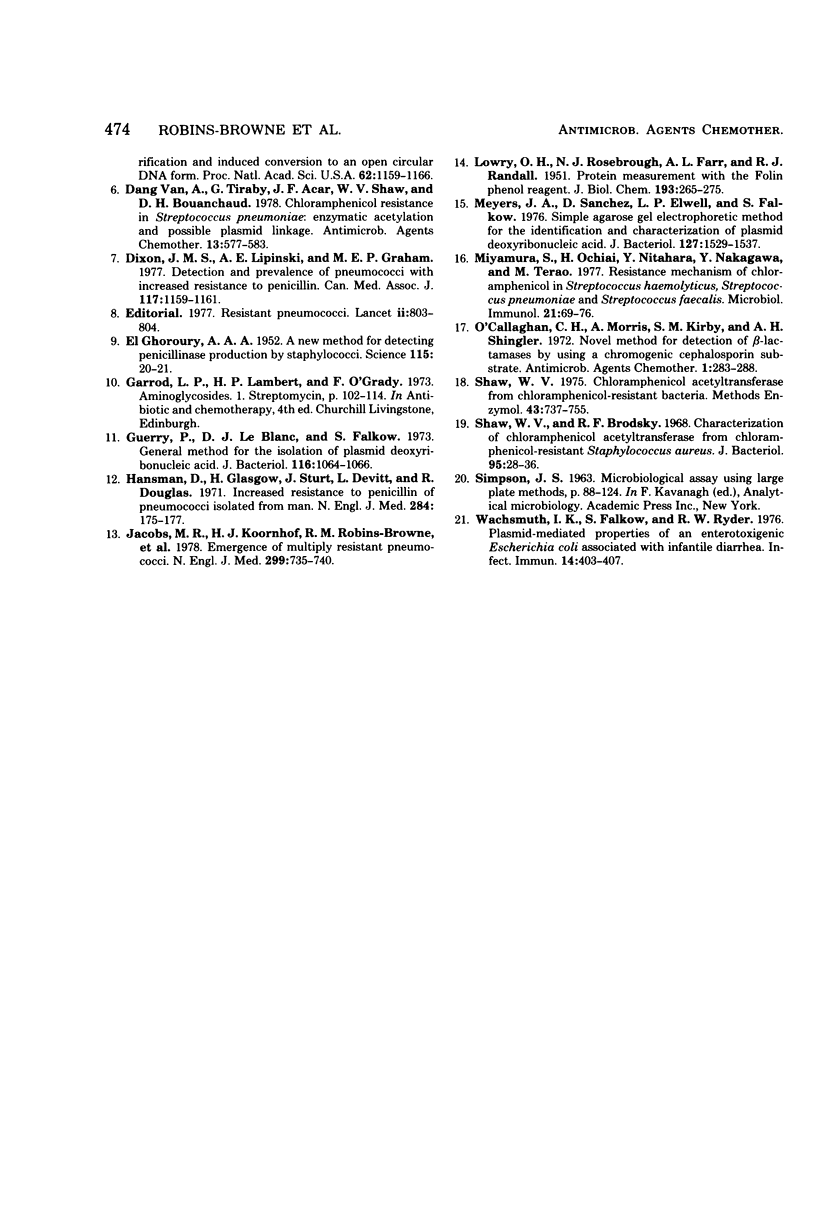
Images in this article
Selected References
These references are in PubMed. This may not be the complete list of references from this article.
- AZIZ A., EL GHOROURY A. A new method for detecting penicillinase production by staphylococci. Science. 1952 Jan 4;115(2975):20–21. doi: 10.1126/science.115.2975.20. [DOI] [PubMed] [Google Scholar]
- Appelbaum P. C., Bhamjee A., Scragg J. N., Hallett A. F., Bowen A. J., Cooper R. C. Streptococcus pneumoniae resistant to penicillin and chloramphenicol. Lancet. 1977 Nov 12;2(8046):995–997. doi: 10.1016/s0140-6736(77)92892-6. [DOI] [PubMed] [Google Scholar]
- CITRI N. DETERMINATION OF PENICILLINASE ACTIVITY. Methods Med Res. 1964;10:221–232. [PubMed] [Google Scholar]
- Dang-Van A., Tiraby G., Acar J. F., Shaw W. V., Bouanchaud D. H. Chloramphenicol resistance in Streptococcus pneumoniae: enzymatic acetylation and possible plasmid linkage. Antimicrob Agents Chemother. 1978 Apr;13(4):577–583. doi: 10.1128/aac.13.4.577. [DOI] [PMC free article] [PubMed] [Google Scholar]
- Dixon J. M., Lipinski A. E., Graham M. E. Detection and prevalence of pneumococci with increased resistance to penicillin. Can Med Assoc J. 1977 Nov 19;117(10):1159–1161. [PMC free article] [PubMed] [Google Scholar]
- Guerry P., LeBlanc D. J., Falkow S. General method for the isolation of plasmid deoxyribonucleic acid. J Bacteriol. 1973 Nov;116(2):1064–1066. doi: 10.1128/jb.116.2.1064-1066.1973. [DOI] [PMC free article] [PubMed] [Google Scholar]
- Hansman D., Glasgow H., Sturt J., Devitt L., Douglas R. Increased resistance to penicillin of pneumococci isolated from man. N Engl J Med. 1971 Jan 28;284(4):175–177. doi: 10.1056/NEJM197101282840403. [DOI] [PubMed] [Google Scholar]
- Jacobs M. R., Koornhof H. J., Robins-Browne R. M., Stevenson C. M., Vermaak Z. A., Freiman I., Miller G. B., Witcomb M. A., Isaäcson M., Ward J. I. Emergence of multiply resistant pneumococci. N Engl J Med. 1978 Oct 5;299(14):735–740. doi: 10.1056/NEJM197810052991402. [DOI] [PubMed] [Google Scholar]
- LOWRY O. H., ROSEBROUGH N. J., FARR A. L., RANDALL R. J. Protein measurement with the Folin phenol reagent. J Biol Chem. 1951 Nov;193(1):265–275. [PubMed] [Google Scholar]
- Meyers J. A., Sanchez D., Elwell L. P., Falkow S. Simple agarose gel electrophoretic method for the identification and characterization of plasmid deoxyribonucleic acid. J Bacteriol. 1976 Sep;127(3):1529–1537. doi: 10.1128/jb.127.3.1529-1537.1976. [DOI] [PMC free article] [PubMed] [Google Scholar]
- Miyamura S., Ochiai H., Nitahara Y., Nakagawa Y., Terao M. Resistance mechanism of chloramphenicol in Streptococcus haemolyticus, Streptococcus pneumoniae and Streptococcus faecalis. Microbiol Immunol. 1977;21(2):69–76. doi: 10.1111/j.1348-0421.1977.tb02809.x. [DOI] [PubMed] [Google Scholar]
- O'Callaghan C. H., Morris A., Kirby S. M., Shingler A. H. Novel method for detection of beta-lactamases by using a chromogenic cephalosporin substrate. Antimicrob Agents Chemother. 1972 Apr;1(4):283–288. doi: 10.1128/aac.1.4.283. [DOI] [PMC free article] [PubMed] [Google Scholar]
- Shaw W. V., Brodsky R. F. Characterization of chloramphenicol acetyltransferase from chloramphenicol-resistant Staphylococcus aureus. J Bacteriol. 1968 Jan;95(1):28–36. doi: 10.1128/jb.95.1.28-36.1968. [DOI] [PMC free article] [PubMed] [Google Scholar]
- Shaw W. V. Chloramphenicol acetyltransferase from chloramphenicol-resistant bacteria. Methods Enzymol. 1975;43:737–755. doi: 10.1016/0076-6879(75)43141-x. [DOI] [PubMed] [Google Scholar]
- Wachsmuth I. K., Falkow S., Ryder R. W. Plasmid-mediated properties of a heat-stable enterotoxin-producing Escherichia coli associated with infantile diarrhea. Infect Immun. 1976 Aug;14(2):403–407. doi: 10.1128/iai.14.2.403-407.1976. [DOI] [PMC free article] [PubMed] [Google Scholar]



